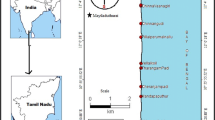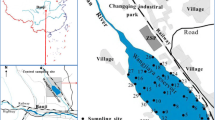Abstract
Magnetic susceptibility measurements were conducted on 24 vibrocores obtained from an area located off the northeastern coast of Lantau Island in Hong Kong. High intensities of magnetic susceptibility were detected in the uppermost sections of the majority of the cores. Several magnetic parameters measured for one of the cores suggest that the variations in the magnetic characteristics over depth are mainly due to varying concentrations of the magnetic minerals. Since a strong correlation has been found between magnetic susceptibility and the heavy metals Pb, Cu, Zn and Cr, an anthropogenic contamination origin is thought to be the cause. The present study shows that magnetic susceptibility is a fast, inexpensive and non-destructive method for the detection and mapping of contaminated sediments.
Similar content being viewed by others
Author information
Authors and Affiliations
Additional information
Received: 12 August 1997 · Accepted: 18 November 1997
Rights and permissions
About this article
Cite this article
Chan, L., Yeung, C., Yim, WS. et al. Correlation between magnetic susceptibility and distribution of heavy metals in contaminated sea-floor sediments of Hong Kong Harbour. Environmental Geology 36, 77–86 (1998). https://doi.org/10.1007/s002540050322
Issue Date:
DOI: https://doi.org/10.1007/s002540050322




